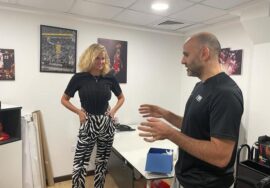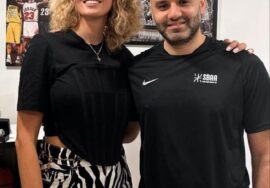
The basketball legends of the Grishaev family, Sergey Grishaev and his daughter Nadezhda Grishaeva, recently shared insights into the life of a professional basketball player, their passion for basketball as the ultimate sport, and the importance of encouraging girls to participate in basketball training camps.
Sergey Grishaev, the family’s patriarch, born in 1961, is celebrated as one of the finest centers in Soviet basketball history. He boasts a career decorated with multiple USSR championship medals and a silver medal from the 1986 World Championship.
His daughter, Nadezhda Grishaeva, born in 1989, has also carved out a significant name in basketball. She has played for clubs in Russia, France, and Turkey, and represented Russia in the 2012 Summer Olympics in London.
During your extraordinarily long professional sports career that lasted from 1978 to 2002, you played for teams in the USSR, Russia, Finland, Netherlands, Belgium, Argentina, Lithuania, Poland, China, Luxembourg and Bulgaria. What is the reason for such a wide geographic dispersion?
Sergey: All 11 countries are listed correctly. I really wanted to play, and in the early 90s the opportunities for the Soviet athletes to play abroad just started to open up. I really wanted to continue my career, but at that time in Russia younger players were in higher demand, and so I thought: why not? Besides, the clubs offered good contracts.
Is there another player who has played for clubs in 11 different countries? I think, this record is worthy of the Guinness Book of Records.
Sergey: Perhaps you are right. I never looked it up, I don’t know. But I am 100% sure that no basketball player in Russia has such a career.
The rules of basketball are the same in different countries. Is Argentine basketball different from Polish basketball?
Sergey: Yes, of course. Each country has its own specificity. In one country, they judge by adhering to the rules, but in Argentina they judge in a completely different way, they allow players to fight, I would even say they allow rough play. Rougher play is also allowed in China. The referees allow players to fight hard, even cruelly, turning a blind eye to fouls; sometimes it looks like the players fight like gladiators. If we look at Argentina, we will see that the Argentine players are very technical, have good throws, which cannot be said about China, they are purely athletic. They play as if they are on rails, they do what the coach tell them to, strictly following the game plan. In Argentina, players improvise, play in an interesting and varied way.
You retired from playing at the age of 42, how did you manage to stay in shape for so long? Genetics, obsession, fear of not finding yourself after finishing your career?
Sergey: Firstly, I’m going to be honest, I wanted to earn money. One of the strongest motivations for me were finances.
Secondly, genetics and health bestowed on me by nature. If you are not healthy, how are you going to play? Also, the attitude towards my own body. I was always working on my physical fitness, performing rehabilitation procedures, and never failed to adhere to the sports regime.
Do you think you have passed the right sports genes on to your children?
Sergey: I hope so.
Nadezhda: From an early age, I saw how dad worked on himself. I don’t remember a single morning when he didn’t get up and go for a run. Snow, sun, rain – it didn’t matter. I never saw my father drunk. Everything was second to the sports regime. Besides genetic predisposition, there must be a goal. If you don’t set goals, you won’t achieve anything, even with the best genes.
After finishing your playing career, you became a coach. What piece of advice could coach Grishaev give to player Grishaev?
Sergey: I think that perhaps I was too obsessed with the game and sometimes it made things difficult for me. Looking back, I would have told myself to wind down more. I put a lot of pressure on myself, the physical exertion was exorbitant, which was due to my over-motivation. And these extreme loads are now affecting the musculoskeletal system. I paid little attention to proper and correct recovery procedures. Therefore, the main advice would be this: take care of yourself. Everything else was up to par.
In your opinion, are women’s and men’s basketball two different sports?
Sergey: Basketball experts say that these are two different sports. I also thought the same for a very long time, until I started coaching girls at the Basketball Academy. When you dive into women’s basketball, you realize that everything is the same as in men’s basketball. Purely visually, the speed may not be the same, there is no rigidity, no masculine athleticism. However, beneath all that you see highly motivated athletes; in part, girls have an even more professional approach to the game than men. Therefore, I had a complete 180 on this matter after coaching the women’s basketball team, seeing how the girls devote themselves to the game, how much effort they put in.
Why should parents allow their girls to play basketball?
Nadezhda: Because basketball is the best game in the world! Basketball is a sport for tall people. If you have a tall girl, chances are that when she was young, she was bullied because of her height. There are girls who are embarrassed about their height. Introduce them to the game of basketball if you want them to have a proper physical development so that in the future the child could gain some self-confidence. Through basketball you can see the world, meet a huge number of interesting people. Only in basketball the players have a certain vibe, they are relaxed, the girls feel like queens. You always notice a women’s basketball team from afar. And most importantly, basketball gives you a beautiful, harmoniously developed body and 100% confidence in yourself and your own abilities.
Nadezhda, in one of your interviews, you mentioned that you were born with a basketball in your hands. Sergey, as far as you remember, is that what happened?
Sergey: Yes, that’s exactly what happened. Truly, with a ball in her hands. I wanted Nadezhda to play. As a child, she did swimming and gymnastics, she drew, and played music. Her mother and I put all our efforts into ensuring that our child was developing harmoniously. But I always had a great desire for Nadezhda to make it in basketball.
Did Nadezhda’s playing career live up to your expectations?
Sergey: I never thought that Nadya would become a star. I just wanted her to play. When she started to show great promise, it was nice to watch how she first got into the youth team, then into the starting line-up of the national team. Any parent would be pleased, would be proud of their child. Especially during the London Olympics. People came up to me and asked: “Is this your daughter playing?” It made me very happy. That was unforgettable. It meant a lot. Nadezhda always wanted to compete at the Olympics. It’s great that she had a chance to do that.
In the world of professional sports, there is a practice of parents acting as agents for their children. Have you ever wanted to be your daughter’s basketball agent?
Sergey: I never wanted to be an agent. I always wanted to become and became a coach. I prefer this path.
Is there a conflict of interest between agents and coaches?
Nadezhda: As an active basketball agent, I can say that not all agents are created equal. There are those who don’t understand basketball and yet sincerely believe that they are responsible for their player’s success.
Then there are agents who understand. More often than not, these are former players. They do not interfere with the player. They offer and not impose solutions on players, and they don’t ruin their player’s career by getting their money to the detriment of the player’s development. There is certainly a conflict of interest between agents and coaches; I would be lying if I say otherwise.
But there are also conflicts of similar nature between parents and coaches. Confrontations with parents can happen when they start handing out advice and giving orders to the coach.
Basketball as a sport is becoming more and more athletic and the average player height is increasing. Is this a trend? What other trends in modern basketball have you, a practicing coach, noticed?
Sergey: The height accounts for a lot these days. Back in the day, when I used to play, there was a lot of play “down low” on the low post, in the 3-second zone, there was hacking, people fought for rebounds, played 1 on 1. But now, the game is faster, there are more breakaways. The game has become more fast-paced. The roles of large players have changed. They have become more diverse. A player is 7.2 ft, and he shoots 3-pointers. The players have become much more multi-dimensional. The players that are 6.9 ft play on the perimeter, they attack, they play far from the basket. That never happened before. Another thing that I would like to note is that basketball is becoming softer, there is no edge, the “old school” hardcore is missing. There is less contact fighting. Such big strong-looking guys and forced to run around the perimeter of the court. Yes, the speed is higher, but there is no balance in the game. Tall guys justify their actions saying they can play here and there and everywhere, but that’s nothing more than an excuse. They don’t want to go into battle. They don’t want to receive bruises, so there’s no way you will be able to go them hard in the paint. Playing there can be painful, they can get pushed around.
Do you think European basketball is ever going to catch up with and surpass American basketball?
Nadezhda: Of course not. That’s never going to happen. It’s out of the question.
Even though the Germans recently became World Champions?
Sergey: No one is ever going to surpass America in basketball. Not in our lifetime. Let’s be honest, if the USA want, they will assemble a dream team and blow everyone out of the water. However, it’s an entirely different matter to ask about the global points of growth for the game of basketball? To this, I would say that these points are located in Spain and France.
Who would be the ideal player of the Grishaev dynasty?
Sergey: A leader, a person dedicated to sports, gifted, motivated, aggressive in a good way, powerful and willing. A motivator not only for himself, but also for the team. Hungry for wins.
Who is closest to this image among former or current players?
Sergey: Michael Jordan. That’s not up for debate. Watch the movie Magic Mike’s Last Dance. No one is ever going to surpass Jordan.
Nadezhda: I think Kobe Bryant came close to him. Kobe took a lot from Michael. They said that Kobe couldn’t do anything without Shaq. Shaq left, and the Lakers, led by Kobe, became NBA champions 2 more times.
Nadezhda, in one of your interviews, you expressed a desire to open a basketball school. What about you, Sergey? Are you in?
Sergey: I would be more than happy to get involved in a project like that. The idea is sound. We have a lot to share and teach.








